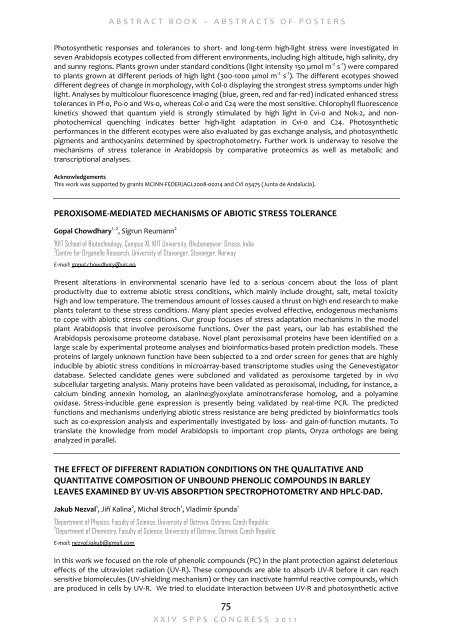1. Front Cover.cdr - CORE
1. Front Cover.cdr - CORE
1. Front Cover.cdr - CORE
Create successful ePaper yourself
Turn your PDF publications into a flip-book with our unique Google optimized e-Paper software.
A B S T R A C T B O O K – A B S T R A C T S O F P O S T E R S<br />
Photosynthetic responses and tolerances to short- and long-term high-light stress were investigated in<br />
seven Arabidopsis ecotypes collected from different environments, including high altitude, high salinity, dry<br />
and sunny regions. Plants grown under standard conditions (light intensity 150 µmol m -2 s -1 ) were compared<br />
to plants grown at different periods of high light (300-1000 µmol m -2 s -1 ). The different ecotypes showed<br />
different degrees of change in morphology, with Col-0 displaying the strongest stress symptoms under high<br />
light. Analyses by multicolour fluorescence imaging (blue, green, red and far-red) indicated enhanced stress<br />
tolerances in Pf-0, Po-0 and Ws-0, whereas Col-0 and C24 were the most sensitive. Chlorophyll fluorescence<br />
kinetics showed that quantum yield is strongly stimulated by high light in Cvi-0 and Nok-2, and nonphotochemical<br />
quenching indicates better high-light adaptation in Cvi-0 and C24. Photosynthetic<br />
performances in the different ecotypes were also evaluated by gas exchange analysis, and photosynthetic<br />
pigments and anthocyanins determined by spectrophotometry. Further work is underway to resolve the<br />
mechanisms of stress tolerance in Arabidopsis by comparative proteomics as well as metabolic and<br />
transcriptional analyses.<br />
Acknowledgements<br />
This work was supported by grants MCINN-FEDER/AGL2008-00214 and CVI 03475 (Junta de Andalucía).<br />
PEROXISOME-MEDIATED MECHANISMS OF ABIOTIC STRESS TOLERANCE<br />
Gopal Chowdhary 1, 2 , Sigrun Reumann 2<br />
1 KIIT School of Biotechnology, Campus XI, KIIT University, Bhubaneswar, Orissa, India<br />
2 Centre for Organelle Research, University of Stavanger, Stavanger, Norway<br />
E-mail: gopal.chowdhary@uis.no<br />
Present alterations in environmental scenario have led to a serious concern about the loss of plant<br />
productivity due to extreme abiotic stress conditions, which mainly include drought, salt, metal toxicity<br />
high and low temperature. The tremendous amount of losses caused a thrust on high end research to make<br />
plants tolerant to these stress conditions. Many plant species evolved effective, endogenous mechanisms<br />
to cope with abiotic stress conditions. Our group focuses of stress adaptation mechanisms in the model<br />
plant Arabidopsis that involve peroxisome functions. Over the past years, our lab has established the<br />
Arabidopsis peroxisome proteome database. Novel plant peroxisomal proteins have been identified on a<br />
large scale by experimental proteome analyses and bioinformatics-based protein prediction models. These<br />
proteins of largely unknown function have been subjected to a 2nd order screen for genes that are highly<br />
inducible by abiotic stress conditions in microarray-based transcriptome studies using the Genevestigator<br />
database. Selected candidate genes were subcloned and validated as peroxisome targeted by in vivo<br />
subcellular targeting analysis. Many proteins have been validated as peroxisomal, including, for instance, a<br />
calcium binding annexin homolog, an alanine:glyoxylate aminotransferase homolog, and a polyamine<br />
oxidase. Stress-inducible gene expression is presently being validated by real-time PCR. The predicted<br />
functions and mechanisms underlying abiotic stress resistance are being predicted by bioinformatics tools<br />
such as co-expression analysis and experimentally investigated by loss- and gain-of-function mutants. To<br />
translate the knowledge from model Arabidopsis to important crop plants, Oryza orthologs are being<br />
analyzed in parallel.<br />
THE EFFECT OF DIFFERENT RADIATION CONDITIONS ON THE QUALITATIVE AND<br />
QUANTITATIVE COMPOSITION OF UNBOUND PHENOLIC COMPOUNDS IN BARLEY<br />
LEAVES EXAMINED BY UV-VIS ABSORPTION SPECTROPHOTOMETRY AND HPLC-DAD.<br />
Jakub Nezval 1 , Jiří Kalina 2 , Michal štroch 1 , Vladimír špunda 1<br />
1 Department of Physics, Faculty of Science, University of Ostrava, Ostrava, Czech Republic<br />
2 Department of Chemistry, Faculty of Science, University of Ostrava, Ostrava, Czech Republic<br />
E-mail: nezval.jakub@gmail.com<br />
In this work we focused on the role of phenolic compounds (PC) in the plant protection against deleterious<br />
effects of the ultraviolet radiation (UV-R). These compounds are able to absorb UV-R before it can reach<br />
sensitive biomolecules (UV-shielding mechanism) or they can inactivate harmful reactive compounds, which<br />
are produced in cells by UV-R. We tried to elucidate interaction between UV-R and photosynthetic active<br />
75<br />
X X I V S P P S C O N G R E S S 2 0 1 1


